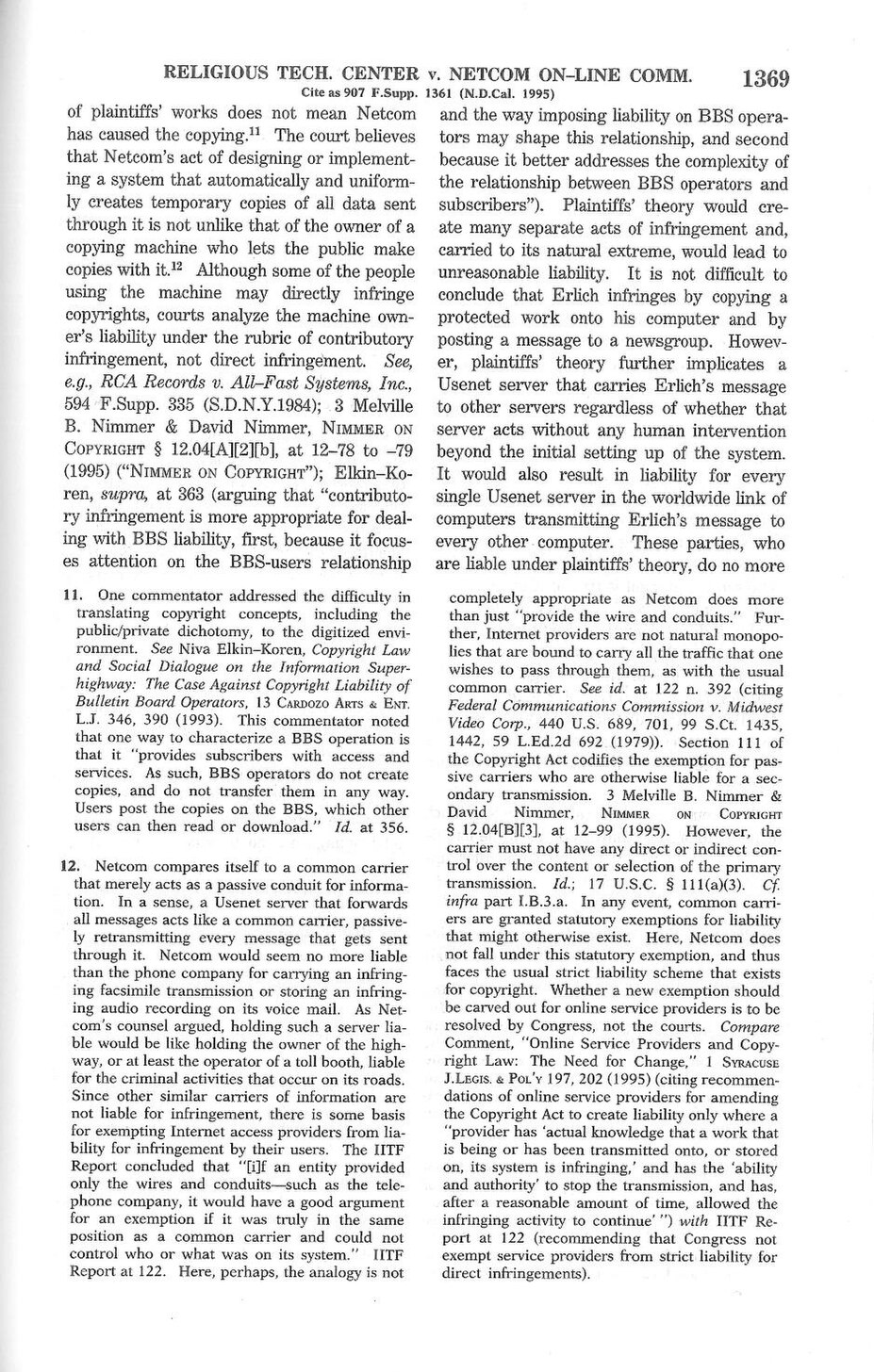Cite as 907 F.Supp. 1361 (N.D.Cal. 1995)
of plaintiffs’ works does not mean Netcom has caused the copying.[1] The court believes that Netcom’s act of designing or implementing a system that automatically and uniformly creates temporary copies of all data sent through it is not unlike that of the owner of a copying machine who lets the public make copies with it.[2] Although some of the people using the machine may directly infringe copyrights, courts analyze the machine owner’s liability under the rubric of contributory infringement, not direct infringement. See, e.g., RCA Records v. All-Fast Systems, Inc., 594 F.Supp. 335 (S.D.N.Y.1984); 3 Melville B. Nimmer & David Nimmer, Nimmer on Copyright § 12.04[A][2][b], at 12-78 to -79 (1995) (“Nimmer on Copyright”); Elkin-Koren, supra, at 363 (arguing that “contributory infringement is more appropriate for dealing with BBS liability, first, because it focuses attention on the BBS-users relationship and the way imposing liability on BBS operators may shape this relationship, and second because it better addresses the complexity of the relationship between BBS operators and subscribers”). Plaintiffs’ theory would create many separate acts of infringement and, carried to its natural extreme, would lead to unreasonable liability. It is not difficult to conclude that Erlich infringes by copying a protected work onto his computer and by posting a message to a newsgroup. However, plaintiffs’ theory further implicates a Usenet server that carries Erlich’s message to other servers regardless of whether that server acts without any human intervention beyond the initial setting up of the system. It would also result in liability for every single Usenet server in the worldwide link of computers transmitting Erlich’s message to every other computer. These parties, who are liable under plaintiffs’ theory, do no more
- ↑ One commentator addressed the difficulty in translating copyright concepts, including the public/private dichotomy, to the digitized environment. See Niva Elkin-Koren, Copyright Law and Social Dialogue on the Information Superhighway: The Case Against Copyright Liability of Bulletin Board Operators, 13 Cardozo Arts & Ent. L.J. 346, 390 (1993). This commentator noted that one way to characterize a BBS operation is that it “provides subscribers with access and services. As such, BBS operators do not create copies, and do not transfer them in any way. Users post the copies on the BBS, which other users can then read or download.” Id. at 356.
- ↑ Netcom compares itself to a common carrier that merely acts as a passive conduit for information. In a sense, a Usenet server that forwards all messages acts like a common carrier, passively retransmitting every message that gets sent through it. Netcom would seem no more liable than the phone company for carrying an infringing facsimile transmission or storing an infringing audio recording on its voice mail. As Netcom’s counsel argued, holding such a server liable would be like holding the owner of the highway, or at least the operator of a toll booth, liable for the criminal activities that occur on its roads. Since other similar carriers of information are not liable for infringement, there is some basis for exempting Internet access providers from liability for infringement by their users. The IITF Report concluded that “[i]f an entity provided only the wires and conduits—such as the telephone company, it would have a good argument for an exemption if it was truly in the same position as a common carrier and could not control who or what was on its system.” IITF Report at 122. Here, perhaps, the analogy is not completely appropriate as Netcom does more than just “provide the wire and conduits.” Further, Internet providers are not natural monopolies that are bound to carry all the traffic that one wishes to pass through them, as with the usual common carrier. See id. at 122 n. 392 (citing Federal Communications Commission v. Midwest Video Corp., 440 U.S. 689, 701, 99 S.Ct. 1435, 1442, 59 L.Ed.2d 692 (1979)). Section 111 of the Copyright Act codifies the exemption for passive carriers who are otherwise liable for a secondary transmission. 3 Melville B. Nimmer & David Nimmer, Nimmer on Copyright § 12.04[B][3], at 12-99 (1995). However, the carrier must not have any direct or indirect control over the content or selection of the primary transmission. Id.; 17 U.S.C. § 111(a)(3). Cf. infra part I.B.3.a. In any event, common carriers are granted statutory exemptions for liability that might otherwise exist. Here, Netcom does not fall under this statutory exemption, and thus faces the usual strict liability scheme that exists for copyright. Whether a new exemption should be carved out for online service providers is to be resolved by Congress, not the courts. Compare Comment, “Online Service Providers and Copyright Law: The Need for Change,” 1 Syracuse J.Legis. & Pol’y 197, 202 (1995) (citing recommendations of online service providers for amending the Copyright Act to create liability only where a “provider has ‘actual knowledge that a work that is being or has been transmitted onto, or stored on, its system is infringing,’ and has the ‘ability and authority’ to stop the transmission, and has, after a reasonable amount of time, allowed the infringing activity to continue’ ”) with TITF Report at 122 (recommending that Congress not exempt service providers from strict liability for direct infringements).
